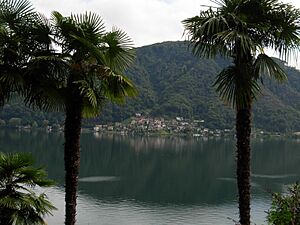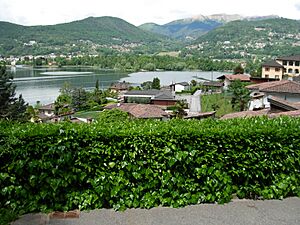Carabietta facts for kids
Quick facts for kids
Carabietta
|
||
|---|---|---|
|
||
| Country | Switzerland | |
| Canton | Ticino | |
| District | Lugano | |
| Area | ||
| • Total | 0.46 km2 (0.18 sq mi) | |
| Elevation | 298 m (978 ft) | |
| Population
(December 2004)
|
||
| • Total | 116 | |
| • Density | 252/km2 (653/sq mi) | |
| Postal code |
6919
|
|
| Surrounded by | Caslano, Collina d'Oro, Lugano, Magliaso | |
Carabietta used to be a small town, or municipality, in Switzerland. It was located in the Ticino region, near the city of Lugano. On April 1, 2012, Carabietta joined with another town called Collina d'Oro to form a larger municipality.
Contents
Carabietta's Past: A Look at its History
Carabietta was first written about in the year 1335. Back then, it was called Carabio. Later, in 1375, people referred to it as La Carabieta.
For a long time, Carabietta was part of larger areas. In the late 1300s, it belonged to a region called Pieve of Agno. Later, in the 1400s and 1500s, it was part of the Pieve of Lugano. Eventually, it became connected to the main church in Morcote.
Between 1803 and 1816, Carabietta was officially part of the municipality of Morcote. During the Middle Ages, Carabietta had a special status. It was known as an imperial cassina, which meant it was free from certain taxes. This special status was confirmed many times over the centuries.
The local church, San Bernardo, was built in 1634. It stands on the foundations of an even older church from the late Middle Ages. For many years, people in Carabietta earned money from farming. They also relied on money sent home by family members who had moved away to work.
Carabietta was one of the smallest municipalities in the Ticino region. Today, it is slowly becoming a place where people live but travel to other towns for work. It shares some services, like schools and finances, with the nearby towns of Barbengo and Grancia.
Where is Carabietta? Its Geography
Carabietta is a small place, covering about 0.46 square kilometers (0.18 square miles). A small part of this land, about 13%, is used for farming. Most of the area, nearly 74%, is covered by forests. The remaining land, about 17%, has buildings and roads.
Most of the built-up area is made up of houses and other buildings. A smaller part is used for roads and transportation. The forests in Carabietta are mostly dense, thick woods. The farmland is mainly used for grazing animals in alpine pastures.
This former municipality is located in the Lugano district. It sits right on the Agno arm of Lake Lugano, which is a beautiful lake.
Carabietta's Coat of Arms
Every town has a special symbol called a coat of arms. Carabietta's coat of arms has a red background. It shows a silver wall with three special "fishtail" shaped tops. Below the wall, there's a blue base with two wavy blue lines. This design represents the town's history and location.
Who Lives in Carabietta? Demographics
In 2008, about 15.5% of the people living in Carabietta were foreign nationals. Over ten years, from 1997 to 2007, the number of people living there grew by about 22.4%.
Most people in Carabietta speak Italian, which is 72% of the population. The second most common language is German, spoken by 17% of residents. About 5% of the people speak English.
In 2008, the population was made up of 45% men and 55% women. About 35% of the population were Swiss men, and 10% were non-Swiss men. Swiss women made up 45% of the population, and non-Swiss women made up 10%.
The age groups in Carabietta in 2009 showed that about 3.3% were children under 9. Teenagers, aged 10 to 19, made up about 15.8%. Adults between 40 and 49 were the largest group, making up about 29.2% of the population.
The chart below shows how Carabietta's population has changed over many years:

Carabietta's Economy: How People Work
In 2007, the unemployment rate in Carabietta was about 5.21%. This means that about 5 out of every 100 people looking for a job couldn't find one.
In 2005, there were 3 businesses in the tertiary sector. This sector includes jobs that provide services, like shops, hotels, or offices. There were 38 people living in Carabietta who had jobs, and about 28.9% of them were women.
In 2000, 5 workers traveled into Carabietta for their jobs. However, 31 workers traveled out of Carabietta to work in other places. This means that many more people leave Carabietta for work than come into it. About 5.3% of working people used public transportation to get to their jobs, while 68.4% used a private car.
Religion in Carabietta
According to the 2000 census, most people in Carabietta are Roman Catholic, making up 71% of the population. About 13% of the people belonged to the Swiss Reformed Church. A small number of people, about 15%, belonged to other churches not listed in the census.
Learning in Carabietta: Education
In Switzerland, most people are well educated. In Carabietta, about 81.7% of adults (aged 25-64) have finished either high school or gone on to higher education, like a university.
In 2009, there were 24 students living in Carabietta. The education system in Ticino offers up to three years of optional kindergarten. In Carabietta, some children attended kindergarten.
The primary school program lasts for five years. In Carabietta, 3 students attended these primary schools. For middle school, students can choose between a two-year program followed by an apprenticeship, or a four-year program to prepare for university. There were 14 students in the two-year middle school and 2 students in the four-year advanced program.
After middle school, students can go to upper secondary school. This prepares them for a trade job or for university. Some students attend school while also doing an internship or apprenticeship. In Carabietta, 1 student was a full-time vocational student, and 3 were part-time. There was also 1 student in a professional program, which prepares them for jobs in fields like engineering or nursing.
In 2000, 9 students from Carabietta went to schools outside the municipality.
See also
 In Spanish: Carabietta para niños
In Spanish: Carabietta para niños







